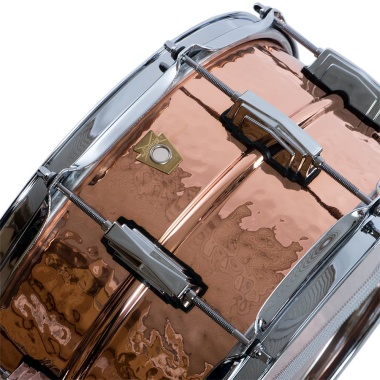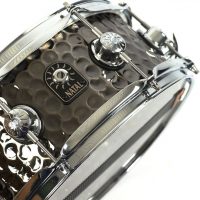Steel, Brass, Aluminium, Copper, Bronze. Odds are most of you will own a snare drum made from one of these materials. What some of you might not be aware of is the difference between them all, sonically at least. Having the right drum for the job helps so here’s a breakdown of what each of these materials will do for your sound and decide what you need for your situation. Lets go!

If a metal snare is what you desire then it’s important to know what each one does as they all provide their own unique sound characteristics. Having at least a rough idea of what each material does will prove vital for achieving the sound you want or need in a live/studio situation. One trait that will always be the case of a metal drum is that they are MUCH louder than wooden alternatives. They’re also brighter and more articulate. That’s all well and good…but which one do YOU need?!?! Well, read below and see if you can decide…

First up is Aluminum. Aluminum drums are extremely light-weight with a dry response. Due to their light-weight and durability, Aluminum drums are the perfect choice if you’re a freelance drummer hopping from gig to gig around the city and need a drum that is a workhorse right out of the gate. Another great plus point of Aluminum drums is their resistance to corrosion. This resistance is the reason you can find vintage Ludwig Acrolite snare drums in decent condition. Not only that but next to Steel, Aluminum drums are the most affordable of all the metal snares. Great examples of Aluminum snares are of course the Ludwig Acrolite, Yamaha Recording Custom, Pearl SensiTone and Tama Starphonic. Speaking of Steel…

In terms of versatility, Steel is KING of it. Typically most beginner or mid-range kits come with a Steel snare. They’ll pretty much do anything you need it to, sonically at least. I mean I can’t guarantee they’ll make a great cup of tea, but I can guarantee they’ll always sound consistent. They’re lovely and bright with great attack that will cut through any mix like butter! Range wise they’ll sit in the in the higher mid-range but to be honest you can achieve a wide range if the snare is deeper. Great examples of quality steel snare would be the Pearl Modern Utility, Gretsch Brooklyn Chrome over Steel, Ludwig Supralite and the Yamaha Recording Custom Steel. If you’re looking for something a tad richer, perhaps Brass might be the way to go…

If you need a drum that responds to the smallest of notes and the largest of hits, Brass is the one. Brass can be a bit of a scary monster, it’s absolutely the loudest of the metals we’ve discussed so far. You don’t need to strike a brass drum hard for it to play hard. Despite its abrasiveness, its surprisingly much darker than the above and packed full of low-end attack. A saught-after feature of any Brass drum is the almighty crack they produce. Good lord is it mighty! Perhaps the most famous Brass snare drum is the Ludwig Black Beauty with its legacy on famous recordings, but even if it hadn’t featured on these songs it would still have a legacy as it’s just so damn good! There’s a reason even top session players endorsed by different drum companies use a Black Beauty live. Of course don’t let that take away from some other fantastic Brass options such as the Mapex Black Panther SledgeHammer, Yamaha Recording Custom, DW Collectors Black Brass and Ludwig Black Magic!

The final two potential options for a metal snare are Bronze and Copper. Being the most expensive material for a metal snare, Bronze shares a lot of similarities with Brass in just how articulate it can be, picking up the smallest of taps to the loudest of hits with great clarity. If you need a metal drum that can light up coffee shops or fill stadiums, you can’t go wrong with Bronze. They’re powerful! Currently we have a DW Knurled Bronze snare that always brings a smile to anyones face who has a play. Copper on the other hand acts almost like a hybrid between wood and metal with a lot of organic warmth and low-end qualities. Ludwig recently released a CopperPhonic snare that has become saught-after due to its versatility and presence on any stage or recording session. Recently a customer of ours also ordered a custom DW Collectors snare in Flat Copper that sounded absolutely incredible. Definitely worth looking into if you need a hybrid sound.

Finally, the last thing to think about is the construction of the shell itself. More specifically, if the shell is Seamless or Hammered as this can also play a crutial role in how the drum will sound regardless of material. Seamless Shells have no interruption in the movement of air within the shell, allowing it to be brighter and louder. Alternatively, Hammered shells rough interior interrupts the flow of air, forcing it to bounce and produce a warmer response, emulating the low wooden tones.

So….have you decided? There is no right or wrong answer, as it’s purely subjective which one you like the best. Sometimes the drum you like the best isn’t the best drum for the situation, which is something to take into account when making a decision. With that said…theres no such thing as “too many snare drums”!


2 Replies to “Metal Snares…What’s The Difference?!”
Ross White
Hi guys, interesting blog. It’s difficult to know the subtle differences between different materials. Following on from this blog, what material would you say gives of the best characteristic crack? I always assumed it would be steel, but I recently played a cranked up Yamaha birch snare which gave out an excellent crack.
Drummers are always searching for that elusive perfect snare sound!
Adam MacEachran[ Post Author ]
Hi Ross! Thanks for reading the blog. That’s a tough question to answer to be honest! Snare sound is SO personal to every single drummer that it’s hard to define one specific material being the best. You’d probably have better luck finding out how long a piece of string is haha! I can only compare to what I personally think is sounds great, and it narrows down to two materials: Brass & Birch.
Brass because it’s loud and has an almighty crack when tuned higher and Birch because it’s dry, focused and direct that can sits well in any range. There’s so many variables too like the heads that are on the drums and the wires. Some of the best sounding snares i’ve heard in a studio didn’t sound like anything special while playing them, so it’s really situational as well.
My advice would be to just experiment with heads & wires until you find what you’re happy with. Hope this helps in some form!
Comments are closed.